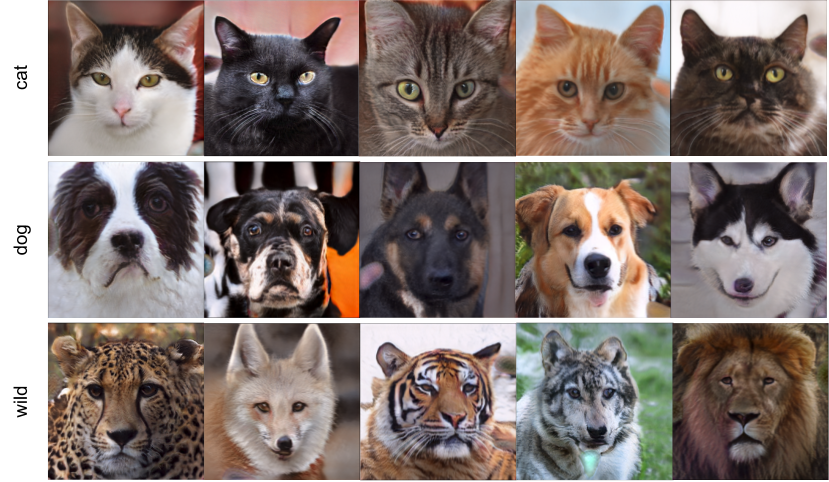GANs have matured in recent years and are able to generate high-resolution, realistic images. However, the computational resources and the data required for the training of high-quality GANs are enormous, and the study of transfer learning of these models is therefore an urgent topic. Many of the available high-quality pretrained GANs are unconditional (like StyleGAN). For many applications, however, conditional GANs are preferable, because they provide more control over the generation process, despite often suffering more training difficulties. Therefore, in this paper, we focus on transferring from high-quality pretrained unconditional GANs to conditional GANs. This requires architectural adaptation of the pretrained GAN to perform the conditioning. To this end, we propose hyper-modulated generative networks that allow for shared and complementary supervision. To prevent the additional weights of the hypernetwork to overfit, with subsequent mode collapse on small target domains, we introduce a self-initialization procedure that does not require any real data to initialize the hypernetwork parameters. To further improve the sample efficiency of the transfer, we apply contrastive learning in the discriminator, which effectively works on very limited batch sizes. In extensive experiments, we validate the efficiency of the hypernetworks, self-initialization and contrastive loss for knowledge transfer on standard benchmarks.
Official implementation of Hyper-Modulation.

Given a pre-trained model, our hyper-modulation method learns to use its knowledge to produce out-of-domain generalizations. I.e., trained on human faces, it quickly learns animal faces (above) or further domains like objects and places (paper). No finetuning is needed. It also preserves and responds to the source domain style mechanism.
Please install the required packages with conda and activate the environment
conda env create -f environment.yml
conda activate hypermodPretrained unconditional models are available in the base code repository, concretely we used this one trained on FFHQ dataset.
Let's assume it's downloaded in <base_model>.
To replicate the stated results, please download AFHQ(v1). Additional datasets like FFHQ, CelebA-HQ, Flowers102standard, Places356 can be downloaded from their respective sources.
Once downloaded and extracted, the dataset must be preprocessed into an LMDB file with the following command
python prepare_data.py <dataset>/train/ --labels --sizes 256 --out <lmdb_dataset>The directory given to prepare_data.py must contain a folder per class, class samples within each respective folder as specified by ImageFolder dataset.
Additionally, we can compute the inception features of the dataset to calculate the metrics later.
python metrics.py <lmdb_dataset> --output_path <dataset_inception_feats> --batch_size 32 --operation extract-featspython self_alignment.py <base_model> --batch_size 32 --name <self_aligned_checkpoints> --checkpoint_interval 1000 --iterations 10000The model checkpoints will begin to get saved under checkpoint/self_align/<self_aligned_checkpoints> folder (can be specified with --checkpoint_dir).
Additional losses are also saved, can be visualized pointing tensorboard to folder runs/self_align/ (can be specified with --log_dir).
To assess the quality we can start computing metrics for each checkpoint with
python metrics.py checkpoint/self_align/<self_aligned_checkpoints> --precomputed_feats <dataset_inception_feats> --batch_size 32 --operation metricsFor each checkpoint, a .metric file will be created containing the computed scores. The function class_mean() from utils.py can be used to read the whole directory.
One would normally want to plot the metric evolution over time, which can be done as
import matplotlib.pyplot as plt
from utils import class_mean
p = 'checkpoint/self_align/<self_aligned_checkpoints>'
plt.plot(*class_mean(p, metric='fid', return_steps=True))We then pick a checkpoint with good enough scores. We will name it <self_aligned_model>.
To run the actual training, we can do
python train.py <lmdb_dataset> --ckpt <self_aligned_model> --max_size 256 --loss r1 --const_alpha 1 --phase 3000000 --batch_default 10 --init_size 256 --mixing --name <training_name> --checkpoint_interval 1000 --iterations 200002For the finetuned version
python train.py <lmdb_dataset> --finetune --ckpt <self_aligned_model> --max_size 256 --loss r1 --const_alpha 1 --phase 3000000 --batch_default 10 --init_size 256 --mixing --name <training_name> --checkpoint_interval 1000 --iterations 200002For the version with contrastive learning
python train.py <lmdb_dataset> --contrastive --ckpt <self_aligned_model> --max_size 256 --loss r1 --const_alpha 1 --phase 3000000 --batch_default 10 --init_size 256 --mixing --name <training_name> --checkpoint_interval 1000 --iterations 200002Generated images and loss curves are found in tensorboard --logdir runs/ by default.
Checkpoints are saved in checkpoint/<training_name>, where metrics can be computed and plotted by using metrics.py script and class_mean plot the same way as for self-alignment.
Additionally, perceptual path length can be computed as
python ppl.py --checkpoint_path <checkpoint/training_name/concrete_checkpoint.model>To make use of the final models, we can directly make use of generate.py or latent_interpolation.py.
To generate a figure like the interpolation from Supplementary Material section 7 (Latent space), run
python latent_interpolation.py <final_checkpoint> --output interpolation_class_noise.png --num_interpolations 5 --type class_noiseThe project is based on this StyleGAN implementation. We used PIQ package for metrics, and the PPL implementation was taken from here.
@InProceedings{Laria_2022_CVPR,
author = {Laria, H\'ector and Wang, Yaxing and van de Weijer, Joost and Raducanu, Bogdan},
title = {Transferring Unconditional to Conditional GANs With Hyper-Modulation},
booktitle = {Proceedings of the IEEE/CVF Conference on Computer Vision and Pattern Recognition (CVPR) Workshops},
month = {June},
year = {2022},
pages = {3840-3849}
}
